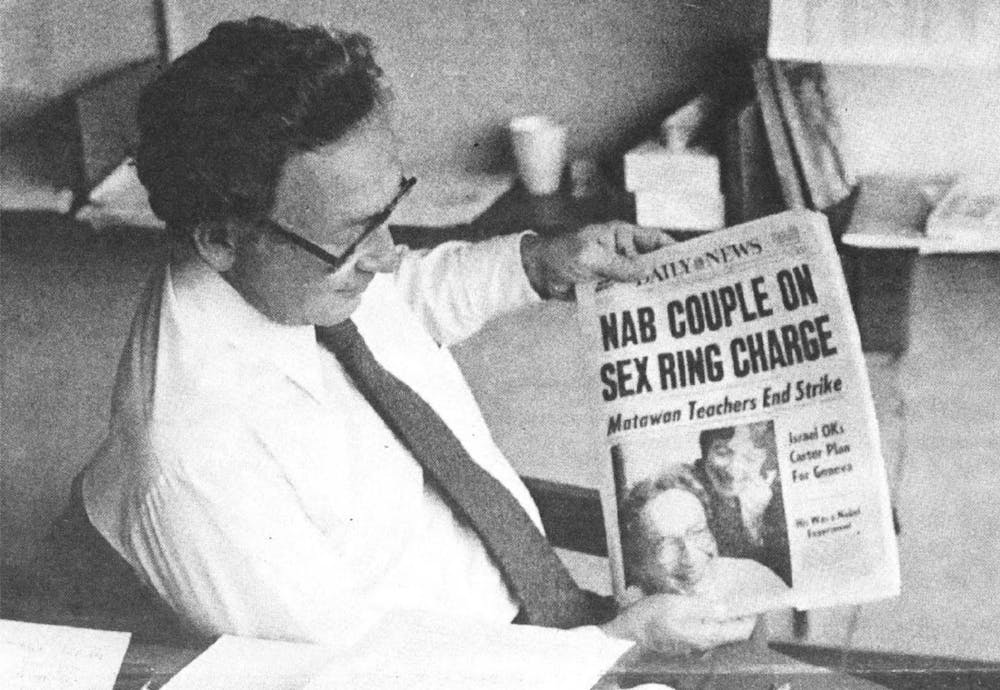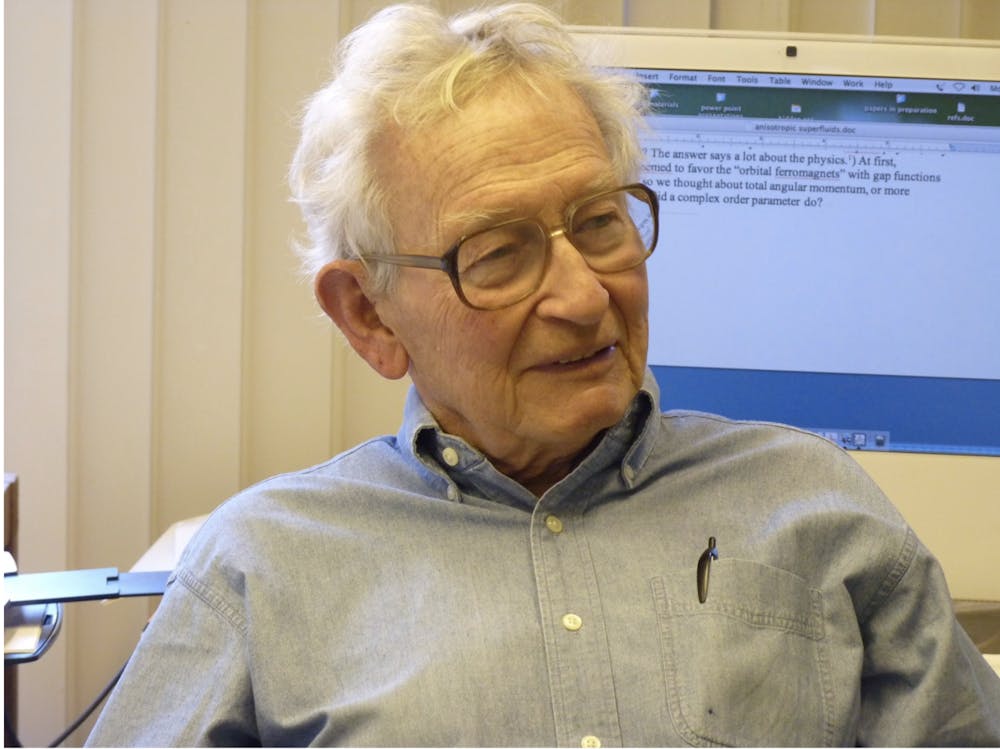The prominent American theoretical physicist and Nobel laureate Phillip W. Anderson, who helped name and shape the field of condensed matter physics, has died at the age of 96.
Anderson was the Joseph Henry Professor of Physics, Emeritus, at the University, where he has been a faculty member since 1975. He died on March 29, 2020, in Princeton Windrows, N.J.
Philip Warren Anderson was born to Harry Warren Anderson and Elsie Eleanor Anderson on December 13, 1923, in Indianapolis, Ind., and spent most of his early life on a farm in Urbana, IL.
Anderson came from a family of “secure but impecunious Midwestern academics”: his father was a professor of plant pathology at the University of Illinois at Urbana; his maternal grandfather was a mathematician at Wabash College in Crawfordsville, Ind., where Anderson’s father studied; and his maternal uncle was a Rhodes Scholar who became a professor of English, also at Wabash College.
Anderson spent much of his childhood hiking, canoeing, picnicking, among other activities. Born just over a month after Adolf Hitler’s Beer Hall Putsch, Anderson and his family observed the political developments in Europe and Asia leading up to the Second World War with “a strong sense of frustration.”
Anderson studied at the University Laboratory High School, where a mathematics teacher named Miles Hartley inspired him to major in mathematics as he enrolled at Harvard University on a fully funded National Scholarship.
After being encouraged to concentrate in “Electronic Physics,” as it was “immediately applicable,” and completing his B.S. in 1943, Anderson was drafted for the war, where he built antennas at the Naval Research Laboratory until the end of the war in 1945.
Anderson then returned to Harvard University for graduate studies under the mentorship of the American physicist John Hasbrouck van Vleck, with whom Anderson would share the 1977 Nobel Prize in Physics a few decades later.

In addition to the “excellent courses... delightful group of friends...bridge, puzzles, and singing” that defined his time at Harvard, Anderson married Joyce Gothwaite and had Susan, their only daughter.
After receiving an M.A. in 1947 and then a Ph.D. in 1949, Anderson found employment at the Bell Telephone Laboratories in Murray Hills, N.J., where he worked among some of the most prominent American physicists of the 20th century, such as Charles Kittel, William Bradford Shockley, and John Bardeen GS ’36, and made many of his career’s most significant discoveries on high-temperature superconductivity, antiferromagnetism, and symmetry breaking.
Shockley would share the 1956 Nobel Prize in Physics with Bardeen, who also went on to share the 1972 Nobel Prize in Physics, becoming the only person in history to win the Nobel Prize in Physics twice.
Humanity’s knowledge of the electronic properties of such materials as metal and semiconductors relies on the concept that an electron is able to traverse through an “ordered” crystalline lattice — a periodic electric potential for electrons to diffract through.

Anderson conducted research in the 1960s that showed that when the potential of such a system is no longer periodic, a “disordered” lattice is produced, which electrons are unable to travel through. A sufficiently powerful “disorder” in the lattice can cause the electrons to be trapped by some atoms, resulting in a phenomenon named by Anderson as “localization,” the discovery of which won him the 1977 Nobel Prize in Physics.
A 1962 paper published by Anderson proposed a process through which a photon could acquire mass within a superconductor. The British theoretical particle physicist Peter Higgs cited the paper two years later in his research, which predicted the existence of an elementary particle — the Higgs boson — the discovery of which by CERN won Higgs and the Belgian physicist Francois Englert the 2013 Nobel Prize in Physics.
The mechanism through which photons gain mass — called the Anderson-Higgs mechanism by many — was central to the research that led up to the crucial step in the development of the Standard Model of Particle Physics.
Professor of Physics Shivaji Sondhi described Anderson as a physicist who carried a strong sense of intellectual independence in his ventures as a physicist.
“[Anderson] had a high ratio of underlying thought to speech and a fierce autonomy of his [intellect]. You would talk to Phil, and he would mostly be in his own universe,” Sondhi said. “Over the years, he would stick with problems, think about them for a long time, tell you what he’d been thinking about, and typically follow his own train of thought.”
In 1967, Anderson took up a faculty position at the Cavendish Laboratory at the University of Cambridge, splitting his time between there and Bell Laboratories.
At Cambridge, Anderson would become the Ph.D. supervisor of F. Duncan Haldane, one of his many doctoral students and now the Sherman Fairchild University Professor of Physics at the University and a co-recipient of the 2016 Nobel Prize in Physics “for theoretical discoveries of topological phase transitions and topological phases of matter.”
Professor emeritus of physics at Cambridge University and recipient of the 1973 Nobel Prize in Physics Brian Josephson, who once enrolled in a class taught by Anderson at Cambridge, found him to be knowledgeable and a “clear and detailed” lecturer when Anderson visited Josephson’s lab group during a sabbatical year in 1961.
At Cambridge, Anderson was the Head of the Theory of Condensed Matter Group, the naming of which meant that Anderson was also responsible for naming the prominent and vibrant field of physics that is now known as condensed matter physics.
Anderson departed from Cambridge in 1975, upon which he took up a part-time faculty position in the Department of Physics at the University, where he remained for the rest of his life.
Just two years after arriving at the University, Anderson would receive the Nobel Prize, shared with his Ph.D. advisor John Hasbrouck van Vleck and the British physicist Sir Nevill Francis Mott, “for their fundamental theoretical investigations of the electronic structure of magnetic and disordered systems.”

Phil Anderson found the news of his winning of the 1977 Nobel Prize in Physics in conflict with other prominent news in a local newspaper.
Photo Credit: Jim Merritt '66
Anderson possessed a strong sense of prescience in his physics career, according to professor of physics and mathematics at New York University Daniel L. Stein GS ’79, who became his doctoral student in the same year he won the Nobel Prize.
“People referred to him as the Delphic Oracle. He would say something that was seemingly incomprehensible at the time. And then maybe a couple of weeks later, I would realize what it was that he was referring to,” Stein remarked, “and of course, it was very deep and insightful because Phil was very prescient; he saw things ahead of others.”
In addition to his contributions to the study of physics, Anderson was also hugely influential in shaping the philosophy of science in the latter half of the 20th century. In an article titled “More is Different,” published in Science Magazine in 1972, Anderson pointed out the limitations of reductionism, which alleged that all of science can be derived from a handful of the most fundamental principles.
Anderson disagreed. Instead, he argued for the concept of “emergence,” which affirmed that even though the phenomena observed at a certain level must obey the laws established at a more primitive level, they can’t always be deduced just by examining those laws. A common example of this idea is that a single copper atom has very little ability to conduct electricity, but millions of copper atoms together can display that capability.
Alongside other prominent scholars such as the economist Kenneth Arrow and fellow physicist Murray Gell-Mann, Anderson would later become involved in the founding of the Santa Fe Institute, an interdisciplinary research institution dedicated to the study of complexity.
T. V. Ramakrishnan, Distinguished Associate at the Centre for Condensed Matter Theory of Indian Institute of Science, Bangalore, who worked alongside Anderson at the University as a visiting fellow and later a visiting professor and visiting research scientist, reflected on the impact Anderson had on his life in an email to the ‘Prince.’
“I first met Anderson in 1977, in Toronto, at a conference there on magnetism in metals. Professor Anderson came to [my] talk, stayed till the end, and later, at one of the coffee breaks, we met. My impression was of a somewhat vague and [unprepossessing] physicist with kind eyes which often twinkled,” Ramakrishnan wrote. “He would just drop into your room. As another physicist said: it was as if Hemingway or Tolstoy came in to chat with a typical writer. Being with him and listening to him transformed my life.”
Anderson became a full-time faculty member at the University in 1984 and was named the Joseph Henry Professor of Physics when he retired from Bell Laboratories after a concession with the federal government resulted in the break-up of AT&T. Anderson transferred to emeritus status in 1996 but continued to be a frequent presence in the physics department.
In a 2006 interview with Physics World, Anderson reflected on his 35-year long career at Bell Laboratories with joy.
“For the first three decades it was the most wonderful laboratory in the world,” Anderson said. “We had freedom, an enlightened management and a personnel department that never had any say in the direction of the research department. We had a very high opinion of ourselves, but it was justified. Those were the years when we invented modern technology.”
Michael Pretko ’13, a postdoctoral researcher in physics at University of Colorado, Boulder, who completed his senior thesis, titled “On the Validity of Hidden Fermi Liquid Theory,” under the mentorship of Anderson described him as “very pensive.”
“Oftentimes, if I asked him a tricky question that he wasn't sure about, he could take a couple of minutes just staring off into space and then answer. So that was always always amusing to watch,” Pretko said. “He always made sure that we met once a week, every week. He felt strongly about meeting with a student on a regular basis in order to keep them on track.”
In addition to his 1977 Nobel Prize, Anderson is also the recipient of numerous other honors, including the Oliver E. Buckley Condensed Matter Prize in 1964 and the National Medal of Science in 1982. Anderson was a Foreign Member of the Royal Society, a member of the American Academy of Arts and Sciences, and a member of the National Academy of Sciences.
Anderson is survived by Joyce Gothwaite, his wife of over seven decades, his daughter, Susan, and three nephews.









